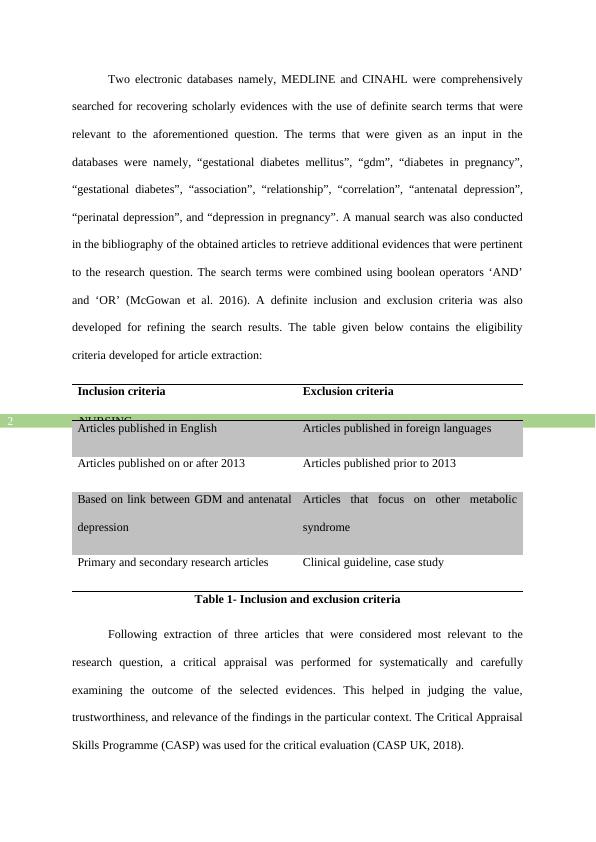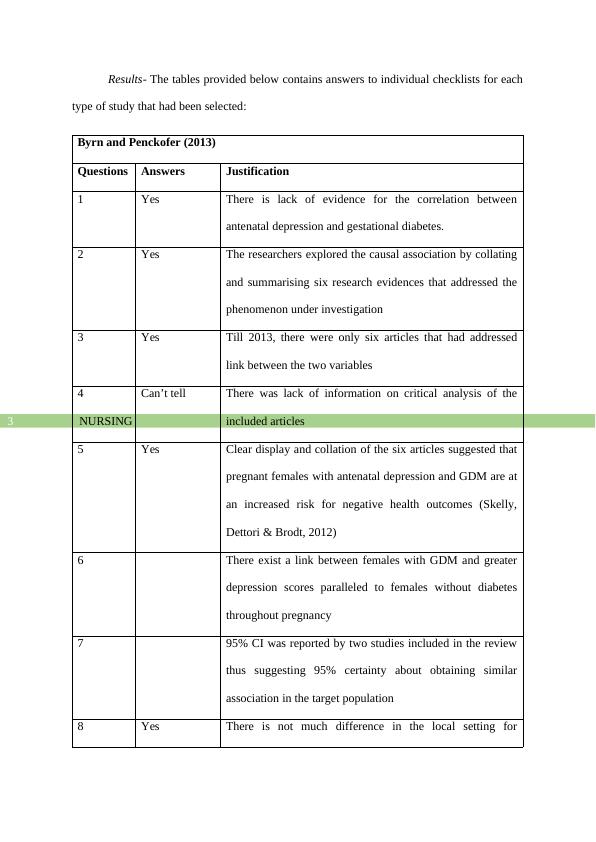Criteria for evaluating evidence on public health
Added on 2022-09-17
15 Pages3948 Words40 Views
Running head: NURSING
PUBH6005: Epidemiology
Name of the Student
Name of the University
Author Note
PUBH6005: Epidemiology
Name of the Student
Name of the University
Author Note

NURSING1
Introduction- According to Jarde et al. (2016) also referred to as prenatal depression,
antenatal depression refers to a type of clinical depression that creates an impact on a female,
at the time of pregnancy. This condition is generally considered as a precursor to postpartum
depression, when left untreated. Time and again it has been found any type of prenatal stress
sensed by the mother creates significant negative consequences on numerous facets of foetal
development, which in turn result in harm to the child and mother (Rice, Langley, Woodford,
Smith & Thapar, 2018). Such antenatal depression is found to occur due to several aspects
that are related to the personal life of the mother, socioeconomic condition, family issues and
relationship status (Castro, Glover, Ehlert & O'Connor, 2017). Following birth, an infant who
is born from a stressed or depressed mother is usually subjected to the repercussions, such
that the child becomes less active, and also experiences emotive distress. In contrast,
gestational diabetes (GDM) refers to the condition when a female demonstrated elevated
levels of blood glucose, usually during pregnancy (Koivusalo et al., 2016). This often
increases the risks of depression, besides augmenting susceptibility to pre-eclampsia and
often the child require caesarean section during delivery. Research evidences have also
established strong correlation between postpartum depression and antenatal depression
(Doyle, 2017). It has often been established by researchers that pregnant women diagnosed
with gestational diabetes, when subjected to a range of lifestyle interventions demonstrated
reduced signs and symptoms of postpartum depression (Lim et al., 2019). This assignment
will therefore contain a critical appraisal of three articles that determine the association
between antenatal depression and gestational diabetes.
Methodology- The extraction of articles was based on formulation of a causal research
question that generally helps in determining whether one or more variables affect or cause
one or more outcomes. The research question used for this assignment is given below:
What is the association between GDM and antenatal depression?
Introduction- According to Jarde et al. (2016) also referred to as prenatal depression,
antenatal depression refers to a type of clinical depression that creates an impact on a female,
at the time of pregnancy. This condition is generally considered as a precursor to postpartum
depression, when left untreated. Time and again it has been found any type of prenatal stress
sensed by the mother creates significant negative consequences on numerous facets of foetal
development, which in turn result in harm to the child and mother (Rice, Langley, Woodford,
Smith & Thapar, 2018). Such antenatal depression is found to occur due to several aspects
that are related to the personal life of the mother, socioeconomic condition, family issues and
relationship status (Castro, Glover, Ehlert & O'Connor, 2017). Following birth, an infant who
is born from a stressed or depressed mother is usually subjected to the repercussions, such
that the child becomes less active, and also experiences emotive distress. In contrast,
gestational diabetes (GDM) refers to the condition when a female demonstrated elevated
levels of blood glucose, usually during pregnancy (Koivusalo et al., 2016). This often
increases the risks of depression, besides augmenting susceptibility to pre-eclampsia and
often the child require caesarean section during delivery. Research evidences have also
established strong correlation between postpartum depression and antenatal depression
(Doyle, 2017). It has often been established by researchers that pregnant women diagnosed
with gestational diabetes, when subjected to a range of lifestyle interventions demonstrated
reduced signs and symptoms of postpartum depression (Lim et al., 2019). This assignment
will therefore contain a critical appraisal of three articles that determine the association
between antenatal depression and gestational diabetes.
Methodology- The extraction of articles was based on formulation of a causal research
question that generally helps in determining whether one or more variables affect or cause
one or more outcomes. The research question used for this assignment is given below:
What is the association between GDM and antenatal depression?

NURSING2
Two electronic databases namely, MEDLINE and CINAHL were comprehensively
searched for recovering scholarly evidences with the use of definite search terms that were
relevant to the aforementioned question. The terms that were given as an input in the
databases were namely, “gestational diabetes mellitus”, “gdm”, “diabetes in pregnancy”,
“gestational diabetes”, “association”, “relationship”, “correlation”, “antenatal depression”,
“perinatal depression”, and “depression in pregnancy”. A manual search was also conducted
in the bibliography of the obtained articles to retrieve additional evidences that were pertinent
to the research question. The search terms were combined using boolean operators ‘AND’
and ‘OR’ (McGowan et al. 2016). A definite inclusion and exclusion criteria was also
developed for refining the search results. The table given below contains the eligibility
criteria developed for article extraction:
Inclusion criteria Exclusion criteria
Articles published in English Articles published in foreign languages
Articles published on or after 2013 Articles published prior to 2013
Based on link between GDM and antenatal
depression
Articles that focus on other metabolic
syndrome
Primary and secondary research articles Clinical guideline, case study
Table 1- Inclusion and exclusion criteria
Following extraction of three articles that were considered most relevant to the
research question, a critical appraisal was performed for systematically and carefully
examining the outcome of the selected evidences. This helped in judging the value,
trustworthiness, and relevance of the findings in the particular context. The Critical Appraisal
Skills Programme (CASP) was used for the critical evaluation (CASP UK, 2018).
Two electronic databases namely, MEDLINE and CINAHL were comprehensively
searched for recovering scholarly evidences with the use of definite search terms that were
relevant to the aforementioned question. The terms that were given as an input in the
databases were namely, “gestational diabetes mellitus”, “gdm”, “diabetes in pregnancy”,
“gestational diabetes”, “association”, “relationship”, “correlation”, “antenatal depression”,
“perinatal depression”, and “depression in pregnancy”. A manual search was also conducted
in the bibliography of the obtained articles to retrieve additional evidences that were pertinent
to the research question. The search terms were combined using boolean operators ‘AND’
and ‘OR’ (McGowan et al. 2016). A definite inclusion and exclusion criteria was also
developed for refining the search results. The table given below contains the eligibility
criteria developed for article extraction:
Inclusion criteria Exclusion criteria
Articles published in English Articles published in foreign languages
Articles published on or after 2013 Articles published prior to 2013
Based on link between GDM and antenatal
depression
Articles that focus on other metabolic
syndrome
Primary and secondary research articles Clinical guideline, case study
Table 1- Inclusion and exclusion criteria
Following extraction of three articles that were considered most relevant to the
research question, a critical appraisal was performed for systematically and carefully
examining the outcome of the selected evidences. This helped in judging the value,
trustworthiness, and relevance of the findings in the particular context. The Critical Appraisal
Skills Programme (CASP) was used for the critical evaluation (CASP UK, 2018).

NURSING3
Results- The tables provided below contains answers to individual checklists for each
type of study that had been selected:
Byrn and Penckofer (2013)
Questions Answers Justification
1 Yes There is lack of evidence for the correlation between
antenatal depression and gestational diabetes.
2 Yes The researchers explored the causal association by collating
and summarising six research evidences that addressed the
phenomenon under investigation
3 Yes Till 2013, there were only six articles that had addressed
link between the two variables
4 Can’t tell There was lack of information on critical analysis of the
included articles
5 Yes Clear display and collation of the six articles suggested that
pregnant females with antenatal depression and GDM are at
an increased risk for negative health outcomes (Skelly,
Dettori & Brodt, 2012)
6 There exist a link between females with GDM and greater
depression scores paralleled to females without diabetes
throughout pregnancy
7 95% CI was reported by two studies included in the review
thus suggesting 95% certainty about obtaining similar
association in the target population
8 Yes There is not much difference in the local setting for
Results- The tables provided below contains answers to individual checklists for each
type of study that had been selected:
Byrn and Penckofer (2013)
Questions Answers Justification
1 Yes There is lack of evidence for the correlation between
antenatal depression and gestational diabetes.
2 Yes The researchers explored the causal association by collating
and summarising six research evidences that addressed the
phenomenon under investigation
3 Yes Till 2013, there were only six articles that had addressed
link between the two variables
4 Can’t tell There was lack of information on critical analysis of the
included articles
5 Yes Clear display and collation of the six articles suggested that
pregnant females with antenatal depression and GDM are at
an increased risk for negative health outcomes (Skelly,
Dettori & Brodt, 2012)
6 There exist a link between females with GDM and greater
depression scores paralleled to females without diabetes
throughout pregnancy
7 95% CI was reported by two studies included in the review
thus suggesting 95% certainty about obtaining similar
association in the target population
8 Yes There is not much difference in the local setting for

End of preview
Want to access all the pages? Upload your documents or become a member.
Related Documents
Prevalence of gestational diabetes and risklg...
|7
|1243
|14
Evidence Based Nursing Researchlg...
|10
|2522
|254
Importance of Perinatal and Postnatal Care for Mothers and Babieslg...
|13
|4080
|105
Association between Depression and Type 2 Diabetes: A Critical Appraisallg...
|12
|2552
|65
Honey Dressing for Wound Healing in Diabetic Patients: A PICO(t) Analysislg...
|23
|2202
|374
Screening for Symptoms of Postpartum Traumatic Stress in Mothers with Preterm Infantslg...
|10
|8203
|134
